Welcome to the fascinating world of ladybugs, also known as lady beetles, where these vibrant insects play a crucial role in our ecosystem. Ladybugs are not just pretty creatures with their bright red or orange bodies adorned with black spots; they are eco-heroes that help maintain the delicate balance of nature. From their colorful shells to their beneficial predatory behavior, ladybugs have captivated the attention and admiration of both scientists and nature enthusiasts alike.
Key Takeaways:
- Ladybugs, or lady beetles, are fascinating insects that contribute to the health of our ecosystem.
- They are known for their vibrant and colorful appearance, with red or orange bodies and black spots.
- Ladybugs play a crucial role in controlling aphids and other plant-eating pests, consuming thousands of insects throughout their lifetime.
- They have defense mechanisms, such as secreting foul-tasting fluid and playing dead, to protect themselves from predators.
- Ladybugs undergo a complete metamorphosis, starting from eggs and progressing through the stages of larva, pupa, and adult.
Stay tuned as we dive deeper into the enchanting world of ladybugs and uncover more fascinating facts about these incredible creatures!
The Colorful Shells of Ladybugs
Ladybugs are renowned for their striking and vibrant appearance, with their red or orange bodies adorned with contrasting black spots, although they can exhibit a wide array of colors and patterns. These colorful shells serve multiple purposes in the world of ladybugs.
One of the main functions of their bright coloration is to serve as a warning to potential predators. Ladybugs contain a substance called hemolymph, which can be toxic to some animals. The vibrant colors act as a visual signal, indicating that they are not a desirable meal. This defense mechanism, known as aposematism, helps keep ladybugs safe from harm.
Additionally, their colorful shells serve as a form of camouflage. Ladybugs are often found in vegetation-rich environments, such as gardens or fields, where their bright colors blend in with the surrounding flowers and leaves. This camouflage makes it difficult for predators to spot them, enhancing their chances of survival.
| Color | Pattern |
|---|---|
| Red | With black spots |
| Orange | With black spots |
| Black | With red spots |
| Yellow | With black spots or stripes |
Ladybugs can also exhibit a range of colors and patterns beyond the classic red with black spots combination. Some species have black bodies with red or orange spots, while others may have yellow bodies with black spots or stripes. This diversity adds to the enchantment of these tiny creatures, making each species unique and captivating.
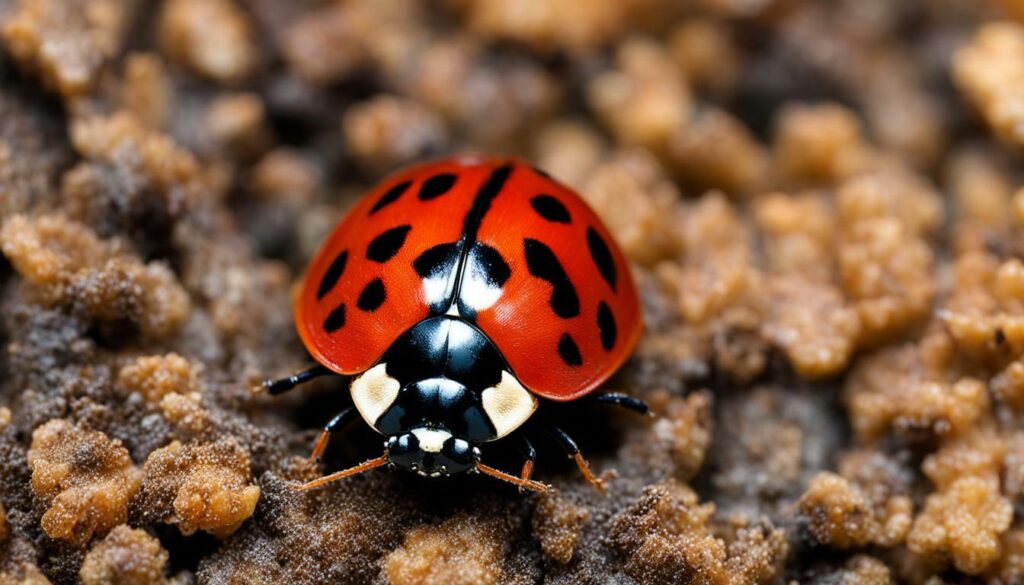
Next time you spot a ladybug, take a moment to appreciate the beauty and complexity of their colorful shells. Whether they’re sporting the traditional red with black spots or showcasing a different color and pattern, ladybugs are truly a sight to behold in the world of insects.
Ladybugs as Beneficial Predators
Did you know that ladybugs are more than just lovely creatures to admire? They serve as incredible predators, feasting on aphids and other harmful plant-eating pests, making them a gardener’s best friend. These tiny superheroes of the insect world help keep our gardens healthy and vibrant. Ladybugs have a voracious appetite and can consume up to 5,000 insects throughout their lifetime! Their preferred delicacy is aphids, those pesky little bugs that can wreak havoc on plants by sucking the sap out of leaves and stems.
When ladybugs find a colony of aphids, they go into attack mode, devouring these harmful pests with gusto. They use their sharp jaws to puncture the aphids and suck out the juices, leaving them with no chance of survival. Ladybugs are so efficient at controlling aphid populations that they are often used as a natural alternative to chemical pesticides in organic farming.
To illustrate just how beneficial ladybugs can be, let’s take a look at a comparison table:
| Pest Control Method | Ladybugs | Chemical Pesticides |
|---|---|---|
| Effectiveness | High | Variable |
| Environmental Impact | Low | High |
| Cost | Low | High |
As you can see, ladybugs offer a highly effective and environmentally friendly solution to pest control. They are nature’s own pest management service, working tirelessly to keep plant-eating insects in check. So the next time you spot a ladybug in your garden, take a moment to appreciate the valuable role it plays in maintaining the balance of nature.
Defense Mechanisms of Ladybugs
Ladybugs may seem delicate, but they possess impressive defense mechanisms that help them fend off potential threats. When faced with danger, these fascinating insects have strategies in place to protect themselves and ensure their survival. One of their most notable defense mechanisms is the ability to secrete a foul-tasting fluid from their joints. This fluid contains chemicals that make ladybugs unappetizing to predators, deterring them from making a meal out of these vibrant beetles.
In addition to their foul-tasting fluid, ladybugs also have the ability to play dead when threatened. By tucking in their legs and closing their wings tightly against their bodies, they appear lifeless, fooling predators into thinking they are no longer a viable source of food. This clever tactic gives ladybugs a chance to escape from potential danger and live another day.
To further protect themselves, ladybugs often display their bright and colorful markings. These vibrant patterns serve as a warning sign to predators, signaling that they are toxic or unpalatable. This visual deterrent helps keep predators at bay, as they learn to associate the striking appearance of ladybugs with an unpleasant taste or potential harm.
| Defense Mechanisms | Description |
|---|---|
| Foul-tasting fluid | Ladybugs can secrete a fluid from their joints that contains chemicals to deter predators. |
| Playing dead | When threatened, ladybugs can tuck in their legs and close their wings tightly, giving the appearance of being lifeless. |
| Colorful markings | Ladybugs display vibrant patterns to warn predators of their toxic or unpalatable nature. |
These defense mechanisms not only protect ladybugs from harm but also serve as a reminder of the unique adaptations that have allowed them to thrive in various habitats. From their foul-tasting fluid to their ability to play dead, ladybugs have an arsenal of tactics to ward off potential threats and ensure their survival in the complex world of insects.

Ladybugs undergo a remarkable metamorphosis, transitioning through different stages before emerging as the beautiful insects we are familiar with. Their life cycle consists of four distinct phases: egg, larva, pupa, and adult. Let’s take a closer look at each of these stages.
Egg:
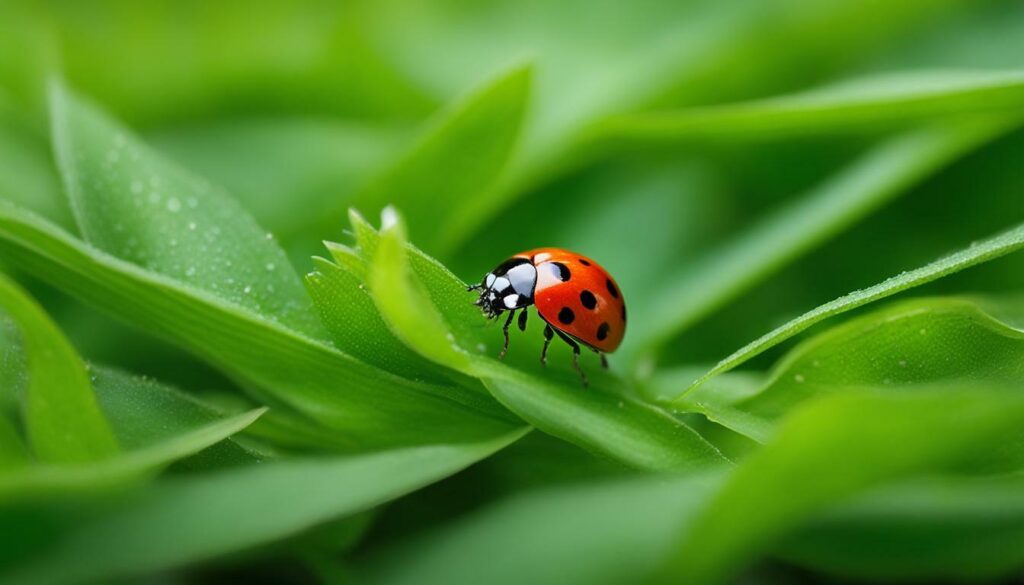 The life cycle of a ladybug begins when a female lays her eggs. Ladybug eggs are usually bright yellow or orange and are laid in clusters on the undersides of leaves. A single ladybug can lay hundreds of eggs in her lifetime. The eggs hatch within a few days, revealing tiny larvae.
The life cycle of a ladybug begins when a female lays her eggs. Ladybug eggs are usually bright yellow or orange and are laid in clusters on the undersides of leaves. A single ladybug can lay hundreds of eggs in her lifetime. The eggs hatch within a few days, revealing tiny larvae.
Larva:
The larva stage is the most active and voracious phase of a ladybug’s life. The larvae look quite different from adult ladybugs, with long bodies and spiky protrusions. They have a strong appetite for aphids and other small insects, consuming them to fuel their growth. As they eat and molt, the larvae go through several stages, gradually becoming larger and more recognizable as ladybugs.
Pupa:
During the pupa stage, the larva attaches itself to a leaf or stem and transforms into a pupa. The pupa is encased in a protective shell called a cocoon, where the transformation from larva to adult takes place. Inside the cocoon, the body undergoes complex changes, including the development of wings and the characteristic coloration of ladybugs.
Adult:
After a period of development, the adult ladybug emerges from the cocoon. Its wings unfold and harden, and the final coloration and spots become visible. Adult ladybugs are ready to explore their environment, mate, and continue the life cycle by laying eggs of their own. Ladybugs can live for several months as adults, contributing to the balance of nature by feeding on plant-eating pests and serving as pollinators.
Next time you spot a ladybug, take a moment to appreciate the fascinating journey it has undergone to become the beautiful and beneficial insect in front of you. The life cycle of ladybugs is a testament to the wonders of nature and the intricate processes that shape the world around us.
Ladybugs’ Preferred Habitats
Ladybugs can be discovered in a range of habitats, from gardens to forests, always seeking out secluded spots to rest and hibernate during the winter months. These charming insects are often found in areas abundant with plants, as they rely on a steady supply of aphids and other plant-eating pests for their diet. You can spot ladybugs in grassy meadows, thriving in the presence of lush greenery and blooming flowers.
When it comes to choosing their habitats, ladybugs have a preference for secluded places that provide shelter and protection. They are often found in leaf litter, shrubs, and tree bark, where they can find crevices and small openings to hide away from predators and harsh weather conditions. Ladybugs are small creatures, and their ability to blend into their surroundings helps them stay safe.
During winter months, ladybugs seek out undisturbed locations to hibernate. These secluded spots can include rock crevices, cracks in tree trunks, and even your cozy garden shed. Ladybugs huddle together in groups, forming clusters to conserve heat and stay warm during the colder months. The inviting warmth of these secluded hideaways ensures their survival until spring arrives.

| Habitat Type | Examples |
|---|---|
| Gardens | Flower beds, vegetable patches |
| Forests | Woodland areas, dense foliage |
| Meadows | Grassy fields, open spaces |
| Shrubs | Hedgerows, bushy areas |
| Tree Bark | Deciduous and coniferous tree trunks |
Next time you venture into nature or work in your garden, keep an eye out for ladybugs. You may just spot these delightful creatures nestled within their preferred habitats, contributing to the wonder and beauty of the natural world.
The Cultural History of Ladybugs
Ladybugs have captured the hearts and imaginations of cultures worldwide, symbolizing good luck and protection throughout history. These charming insects have been revered for their beauty and believed to bring blessings to those who encounter them. From ancient civilizations to modern-day superstitions, ladybugs hold a special place in our cultural heritage.
In many cultures, spotting a ladybug is considered a sign of good fortune. Some believe that making a wish while a ladybug is on your hand will make it come true. In Germany, ladybugs are known as “Gluckskäfer,” meaning “lucky beetles,” and it is customary to leave them unharmed if found indoors. In Slavic folklore, ladybugs are seen as protectors against evil spirits and diseases.
This widespread association with good luck can be traced back to the Middle Ages when farmers would pray to ladybugs to protect their crops from pests. Ladybugs, with their insatiable appetite for aphids and other plant-eating insects, became a symbol of hope and prosperity.
“Ladybugs are a universal symbol of happiness, and their presence brings joy and optimism to those who encounter them.”
As ladybugs adorned fields and gardens, their reputation spread, and they became popular motifs in art and literature. Their vibrant colors and distinctive patterns have inspired artists and designers throughout the centuries. Ladybug-inspired jewelry, clothing, and home decorations continue to be cherished for their whimsical charm.
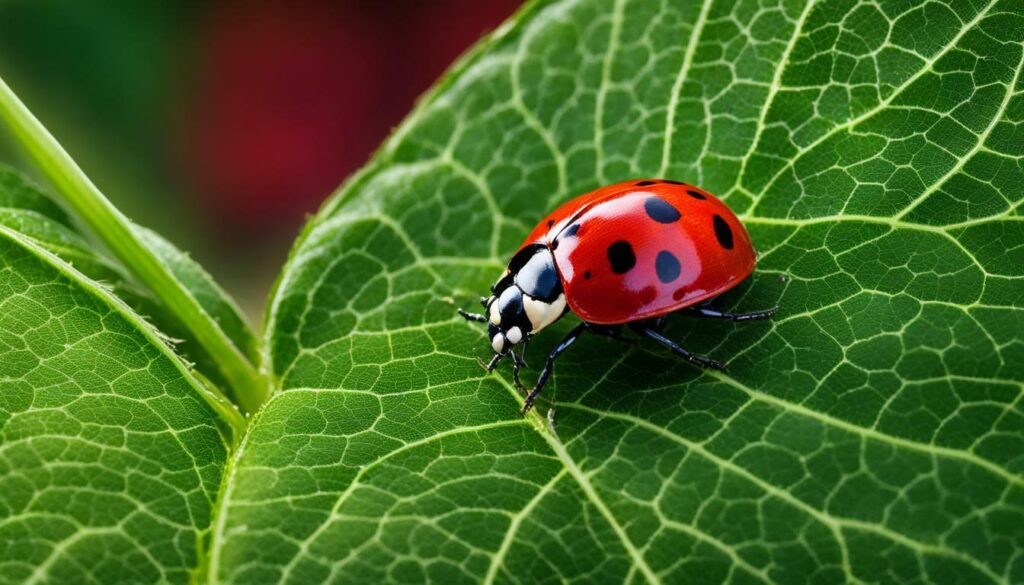
The cultural significance of ladybugs goes beyond luck and protection. In some cultures, ladybugs are also associated with love and relationships. It is believed that if a ladybug lands on you, it is a sign that love is in the air. In others, ladybugs are seen as messengers from loved ones who have passed away.
Furthermore, ladybugs hold spiritual and ecological symbolism. They are seen as reminders of the delicate balance of nature and the interconnectedness of all living beings. Ladybugs’ role as natural pest controllers, keeping plant-eating insects in check, reminds us of the importance of maintaining harmony in the ecosystem.
| Cultural Symbolism | Meaning |
|---|---|
| Good luck | Fortune and blessings |
| Love and relationships | Potential for romance |
| Protection | Warding off evil spirits |
| Harmony in nature | Respecting the interconnectedness of life |
Ladybugs are a universal symbol of happiness, and their presence brings joy and optimism to those who encounter them. Whether you believe in their magical powers or simply appreciate their beauty, ladybugs continue to be cherished as enchanting creatures that connect us to the wonders of nature.
A World of Ladybug Species
Prepare to be amazed by the sheer diversity of ladybug species, as they showcase a myriad of unique characteristics and thrive in a range of environments. From the iconic red or orange bodies with black spots to a kaleidoscope of colors and patterns, ladybugs captivate us with their vibrant exteriors. With over 5,000 species, each contributing to the delicate balance of nature, these enchanting insects are nothing short of remarkable.
Let’s embark on a journey through the fascinating world of ladybug species. Some ladybugs prefer wooded areas, while others thrive in gardens. For example, the Seven-Spotted Ladybug (Coccinella septempunctata) can be found in a variety of habitats, from grasslands to forests. This species has a reddish-orange body adorned with seven black spots, making it instantly recognizable. On the other hand, the Two-Spotted Ladybug (Adalia bipunctata) prefers gardens and agricultural fields and boasts a black body with two distinct red spots.
The Multicolored Asian Lady Beetle (Harmonia axyridis) is another remarkable species known for its wide range of colors and patterns. This ladybug can be red, orange, yellow, or even black, with a varying number of spots or no spots at all. Its adaptability allows it to thrive in diverse climates, making it a successful invader in many parts of the world.
| Species | Unique Characteristics | Preferred Habitat |
|---|---|---|
| Seven-Spotted Ladybug (Coccinella septempunctata) | Reddish-orange body with seven black spots | Grasslands, forests |
| Two-Spotted Ladybug (Adalia bipunctata) | Black body with two distinct red spots | Gardens, agricultural fields |
| Multicolored Asian Lady Beetle (Harmonia axyridis) | Varies in color and pattern, can be red, orange, yellow, or black | Diverse climates |
These are just a few examples of the incredible diversity within the world of ladybugs. Whether they’re hiding in the foliage of a forest or fluttering among the flowers in a garden, ladybugs enrich our surroundings and remind us of the wonders of the natural world. So, next time you spot a ladybug, take a moment to appreciate the unique species that it represents, and marvel at the intricate web of life in which these small creatures play such a vital role.
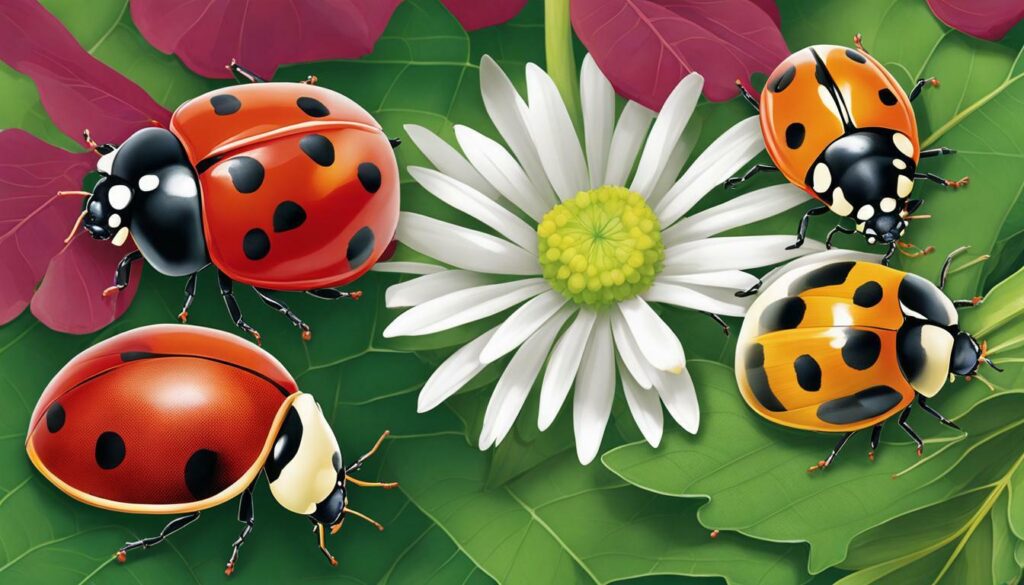
Have you ever wondered if ladybugs need their beauty rest? Let’s uncover the sleeping habits of these captivating creatures. While ladybugs don’t sleep in the same way humans do, they do require periods of rest to recharge and rejuvenate.
Ladybugs are diurnal insects, meaning they are active during the day and rest at night. During their resting periods, ladybugs typically find sheltered spots such as leaves, tree bark, or even inside homes. They may gather in groups, forming clusters called “ladybug huddles” to keep warm and protected from predators.
Although they don’t enter a deep sleep like mammals, ladybugs do reduce their activity and metabolic rate during rest periods. This allows them to conserve energy and maintain their vibrant colors and vitality. So, while they may not snooze like we do, ladybugs certainly know how to find their own version of beauty sleep!

Ladybugs’ unique sleeping habits have fascinated scientists for years. Despite their small size, ladybugs have been found to sleep for extended periods, often lasting several months. This prolonged sleep cycle, known as diapause, helps them survive during harsh weather conditions or when food is scarce.
During diapause, ladybugs enter a state of dormancy where their metabolic processes slow down significantly. This allows them to conserve energy while waiting for more favorable environmental conditions. Ladybugs are incredibly resilient creatures, relying on their ability to adapt and survive in different habitats.
Table: Ladybug Sleep versus Human Sleep
| Ladybugs | Humans | |
|---|---|---|
| Sleep Duration | Extended periods (several months) | 6-8 hours per day |
| Sleep Cycle | Diapause (periods of dormancy) | Multiple sleep stages (REM, NREM) |
| Metabolic Rate | Significantly reduced | Varies throughout sleep cycle |
| Activity Level | Minimal movement | Immobile during deep sleep |
Ladybugs’ sleeping habits are just one of the many fascinating aspects of their lives. From their vibrant colors and beneficial role in ecosystems to their cultural symbolism and diverse species, ladybugs continue to captivate our attention. So, next time you spot a ladybug resting peacefully, remember that even these tiny creatures need their beauty sleep!
Can Ladybugs Swim?
Ladybugs are fascinating insects, but can they conquer the water as effortlessly as they do the land? Let’s dive into the world of ladybugs and explore their swimming abilities!
While ladybugs are primarily known for their ability to crawl and fly, they are also capable swimmers. When faced with bodies of water such as ponds, lakes, or even raindrops, ladybugs can use their wings to paddle through the water. This enables them to navigate across surfaces and reach safety if needed.
In fact, ladybugs’ ability to swim is a unique adaptation that helps them in their pursuit of food and finding suitable habitats. They can move efficiently through water by using a combination of wing movements and leg paddling. This allows them to explore aquatic environments and access resources that may be unavailable on land.
It’s important to note, however, that ladybugs are not built for long-distance swimming. Their swimming abilities are limited to short distances, and they are more proficient in crawling or flying. But when it comes to overcoming obstacles and reaching new territories, ladybugs prove that they can conquer both land and water.
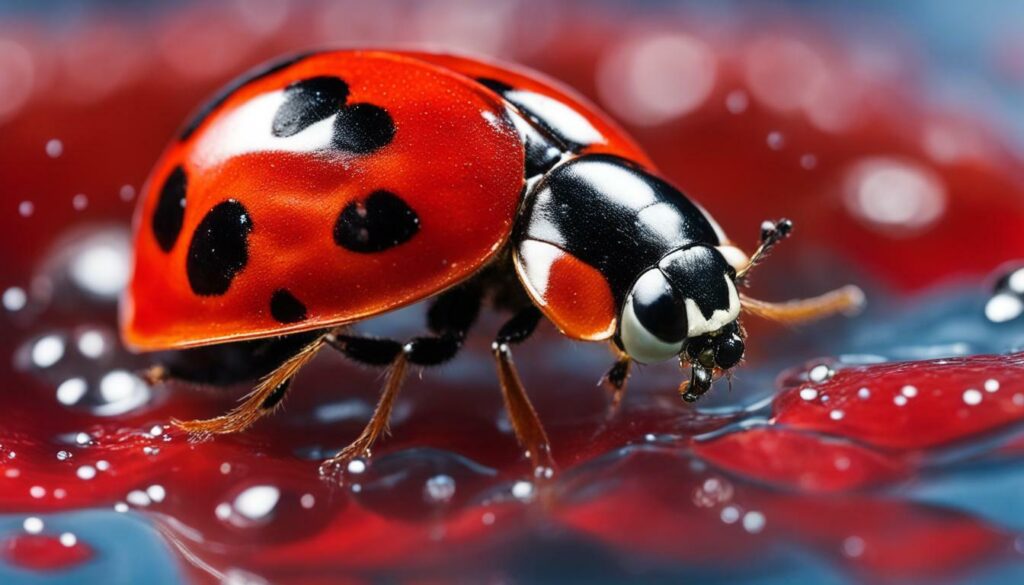
- Look for ladybugs near bodies of water, such as ponds or streams.
- Observe their behavior when faced with water, paying attention to their wing and leg movements.
- Notice how they utilize their swimming abilities to navigate and search for food.
- Keep in mind that ladybugs prefer shallow water, as they are not strong swimmers.
Next time you come across a ladybug near a body of water, take a moment to appreciate their adaptability and resilience. These tiny creatures continue to amaze us with their ability to thrive in various environments, showcasing the wonders of the natural world.
| Ladybug Swimming Adaptations | Benefits |
|---|---|
| Wing movements and leg paddling | Efficient movement through water |
| Ability to navigate across surfaces | Access to new territories and resources |
| Short-distance swimming | Overcoming obstacles and reaching safety |
Ladybugs’ Diet: Do They Eat Grass?
Ladybugs are voracious eaters, but do they share our fondness for grass? Let’s explore their diet and see what these little predators truly feast upon.
Contrary to popular belief, ladybugs do not consume grass as part of their diet. These fascinating insects are primarily carnivorous, with a particular affinity for aphids and other plant-eating pests. In fact, a single ladybug can devour up to 5,000 insects throughout its lifetime, making them invaluable allies in natural pest control.
So what exactly do ladybugs eat? Their preferred meal consists of soft-bodied insects such as aphids, mites, and scale insects. These tiny pests pose a threat to plants, sucking their sap and causing damage. However, ladybugs swoop in to save the day by feasting on these pests, effectively maintaining the health and balance of our gardens and ecosystems.
| Preferred Prey | Dietary Habits |
|---|---|
| Aphids | Main source of food, especially for larvae |
| Mites | Preferable for adult ladybugs |
| Scale Insects | Also targeted by ladybugs |
By controlling the populations of these plant-eating pests, ladybugs provide a valuable service to farmers, gardeners, and the agricultural industry as a whole. Their role as natural predators helps reduce the need for chemical pesticides, promoting a more sustainable and eco-friendly approach to pest management.
So, while ladybugs may not have a taste for grass, they are an essential part of our ecosystem, contributing to the delicate balance of nature. Their diverse diet and voracious appetite for pests make them true eco-heroes in the insect world.
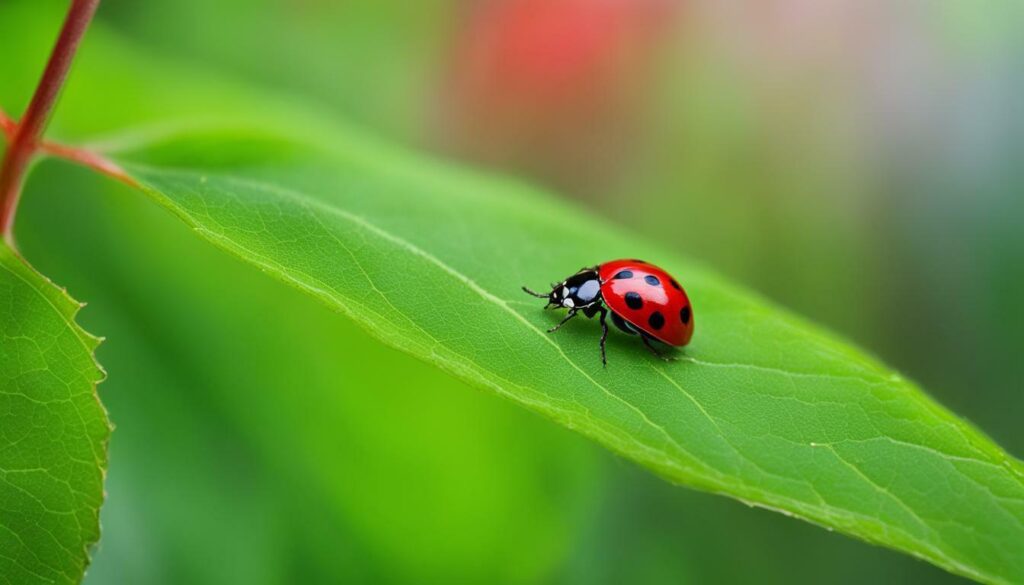
| In Summary: | |
|---|---|
| Ladybugs are carnivorous insects. | They primarily feast on soft-bodied insects like aphids, mites, and scale insects. |
| Ladybugs do not eat grass. | They help control the populations of plant-eating pests, contributing to natural pest management. |
| By consuming thousands of insects in their lifetime, ladybugs play a vital role in maintaining the balance of the ecosystem. | They are eco-heroes in the insect world and promote sustainable pest control practices. |
The Role of Ladybugs in Pollination
Beyond their pest-controlling abilities, ladybugs also play an important role in the pollination process, benefiting both plants and the environment. While bees and butterflies are commonly associated with pollination, ladybugs are often overlooked in this regard. However, these small and colorful insects contribute significantly to the reproduction of many plants.
Ladybugs are attracted to flowers, especially those with open and shallow structures. As they crawl on the petals in search of prey, they unintentionally transfer pollen from male to female flower parts, aiding in fertilization. This accidental pollination helps plants produce seeds and ensure their survival.
Furthermore, ladybugs’ feeding habits indirectly support pollination. By preying on aphids and other herbivorous insects, they help protect the plants from damage. Healthy plants have a better chance of producing vibrant and attractive flowers that serve as food sources for ladybugs and other pollinators.
Research has shown that ladybugs can significantly increase the fruit set and seed production of certain plants. In some cases, plants pollinated by ladybugs have exhibited higher quality and a greater abundance of seeds compared to those relying solely on other pollinators. Therefore, fostering a healthy population of ladybugs in our gardens and natural habitats is crucial for maintaining biodiversity and the overall health of ecosystems.
“Ladybugs not only add beauty to your garden but also contribute to the intricate web of life, pollinating plants and playing a vital role in the delicate balance of nature.” – [Your Name or Attribution]
The Importance of Conservation
Conserving ladybug populations is essential for preserving their pollination services. To attract ladybugs to your garden, provide diverse native plants that offer nectar and pollen sources. Additionally, avoid the use of pesticides, as these chemicals can harm ladybugs and other beneficial insects. By creating a welcoming habitat for ladybugs, you can enjoy their pest-control abilities and contribute to the overall health of the ecosystem.
| Ladybug Species | Preferred Habitat |
|---|---|
| Convergent Ladybug (Hippodamia convergens) | Fields, gardens, meadows |
| Seven-Spotted Ladybug (Coccinella septempunctata) | Gardens, forests, grassy areas |
| Asian Lady Beetle (Harmonia axyridis) | Woodlands, fields, gardens |
| Mealybug Ladybird (Cryptolaemus montrouzieri) | Greenhouses, tropical areas |
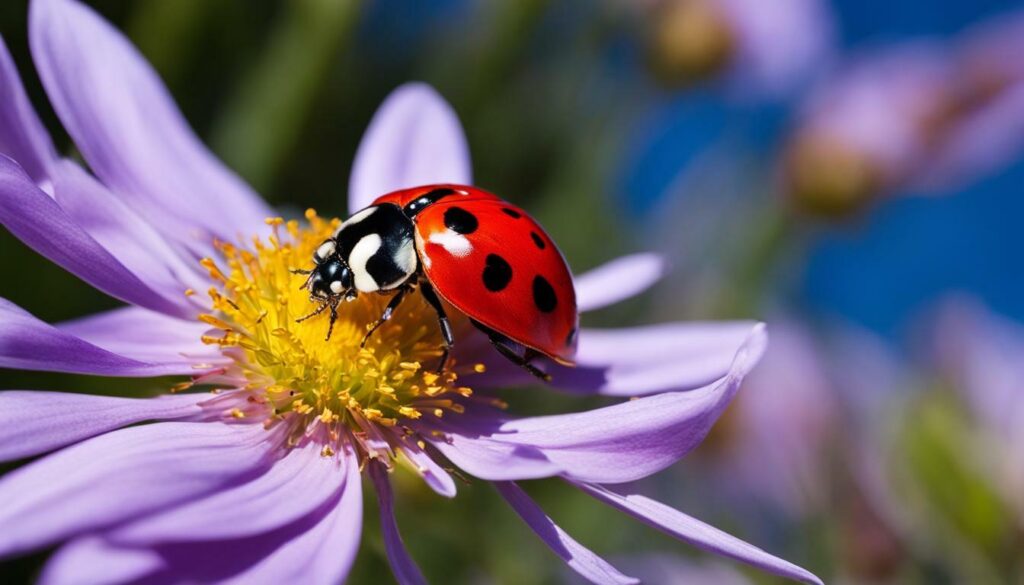
Ladybugs not only add beauty to your garden but also contribute to the intricate web of life, pollinating plants and playing a vital role in the delicate balance of nature. By recognizing their importance and taking steps to protect their habitats, we can ensure that ladybugs continue to thrive and fulfill their crucial ecological roles.
Are Ladybugs Attracted to Light?
We often associate insects with a fascination for light, but what about ladybugs? Are they truly drawn to the glow? Ladybugs, like many other insects, have phototaxis, which means they are attracted to light. However, their behavior towards light differs from other insects that are commonly found hovering around lamps or streetlights.
Ladybugs are diurnal creatures, meaning they are active during the day and tend to rest at night. Unlike nocturnal insects, ladybugs do not rely on light for navigation or mating purposes. Instead, they are more attracted to the warmth and scent that plants emit.
So, if you have ever come across a ladybug near a light source, chances are it is not intentionally seeking out the light but has simply been attracted to the warmth that the light emits. Ladybugs are beneficial insects to have around your garden as they help control aphids and other plant-eating pests. They play an essential role in maintaining the balance of nature and are considered eco-heroes.
To experience the enchanting world of ladybugs and witness their stunning colors and patterns, take a moment to observe these fascinating creatures in their natural habitats. They are a true marvel of nature and a delightful addition to any garden or outdoor space.
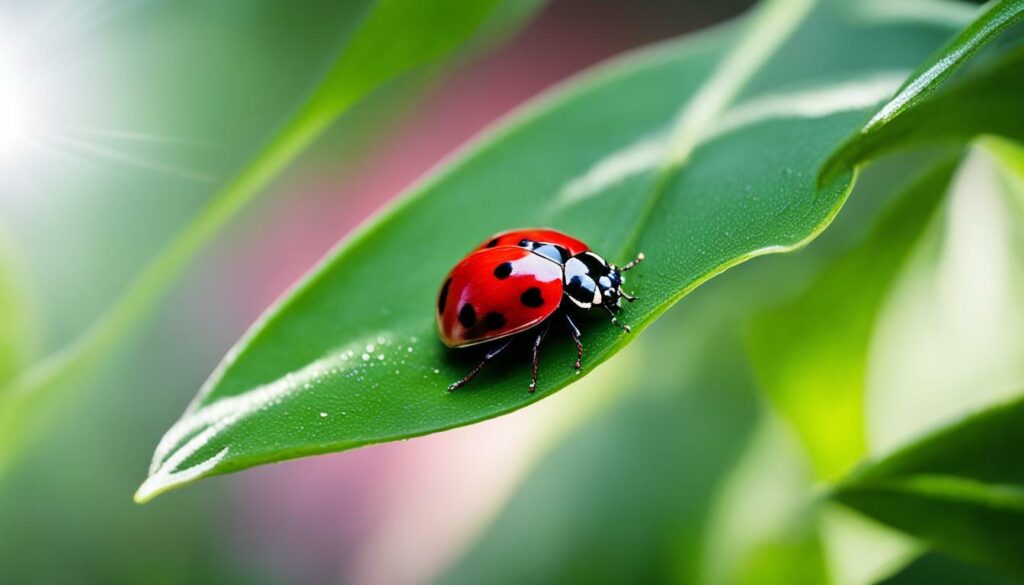
- There are over 5,000 species of ladybugs worldwide, each with its own unique characteristics and preferred habitat.
- Ladybugs undergo a complete metamorphosis, starting as eggs, transforming into larvae, pupae, and finally emerging as adult ladybugs.
- Ladybugs hibernate during the winter months, seeking out secluded places to shelter from the cold.
- Ladybugs have a rich cultural history and are often associated with good luck in many cultures around the world.
“Ladybugs are not only fascinating insects, but they also contribute to the balance of the natural world. Their presence can help control pests and promote a healthy ecosystem. So, the next time you spot a ladybug, take a moment to appreciate the beauty and importance of these little eco-heroes.”
| Fact | Info |
|---|---|
| Common Name | Ladybug |
| Scientific Name | Coccinellidae |
| Family | Coccinellidae |
| Order | Coleoptera |
| Diet | Aphids and other small insects |
| Habitat | Gardens, fields, forests |
| Lifespan | 1 to 2 years |
The Mystery of Ladybug Wings Sticking Out
Have you ever noticed ladybugs with their wings protruding? Let’s unravel the mystery behind this intriguing display. Ladybugs have a unique ability to tuck their delicate wings neatly underneath their outer shell, protecting them from harm. However, there are instances when ladybugs are seen with their wings partially or fully exposed, seemingly defying their usual hidden position.
One possible explanation for this behavior is that ladybugs engage in wing spreading as a way to regulate their body temperature. By extending their wings, they can absorb heat from the sun or cool down when necessary. This tactic allows them to achieve an optimal temperature for their metabolic functions, ensuring they remain active and mobile. So, if you spot a ladybug basking in the sunlight with wings outstretched, it’s likely enjoying a thermal boost.
Another reason for wings sticking out is the signaling aspect. While many insects use sound or chemicals for communication, ladybugs rely on visual signals to convey certain messages. When threatened or agitated, ladybugs may use their wings to flaunt the bright colors and patterns underneath. This display acts as a warning to potential predators, signaling that they are toxic or unappetizing. By exposing their wings, ladybugs effectively say, “Don’t mess with me!”
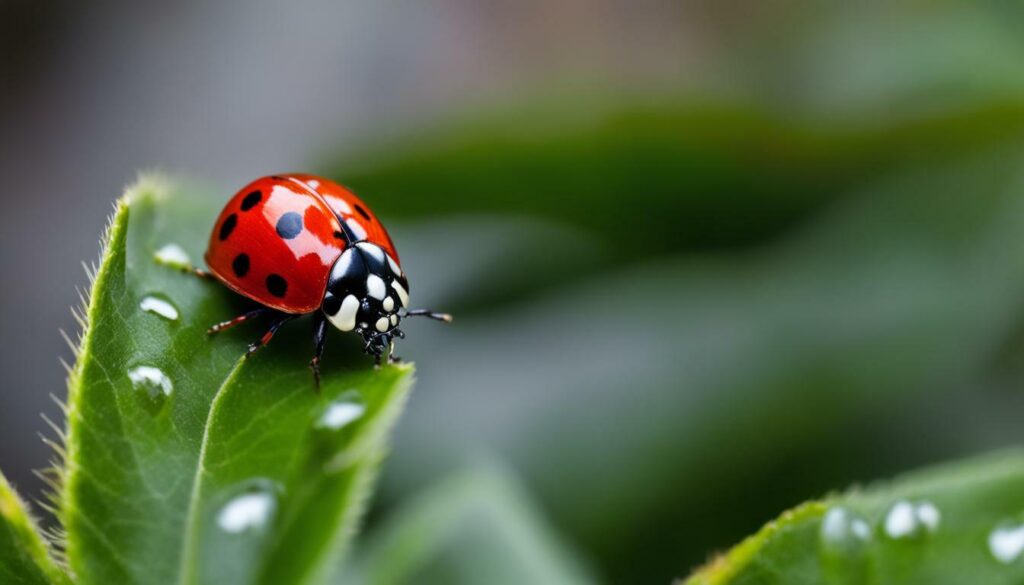
Despite these explanations, there is still much we don’t know about the precise reasons behind ladybug wings sticking out. Scientists continue to study these enigmatic insects, uncovering more secrets about their fascinating behavior. So, the next time you spot a ladybug with its wings on display, take a moment to appreciate the mystery and wonder that these tiny creatures bring to our world.
Ladybugs as Eco-Heroes: Contributing to the Balance of Nature
Ladybugs may be small in size, but their impact on the ecosystem is nothing short of heroic. Let’s appreciate their vital role in maintaining the delicate balance of nature. These colorful insects, also known as lady beetles, play a crucial part in keeping our environment healthy and thriving.
One of the main reasons why ladybugs are considered eco-heroes is their insatiable appetite for plant-eating pests such as aphids. A single ladybug can consume up to 5,000 insects in its lifetime, making them natural and efficient predators. By controlling the population of aphids and other pests, ladybugs help to protect crops and gardens, ensuring a bountiful harvest for humans and providing a sustainable ecosystem for other organisms.
Ladybugs also contribute to the balance of nature through their role in pollination. While often overshadowed by bees and butterflies, ladybugs are essential pollinators, helping flowering plants reproduce and thrive. Their presence ensures the transfer of pollen between flowers, enabling the production of fruits, seeds, and new plant life.
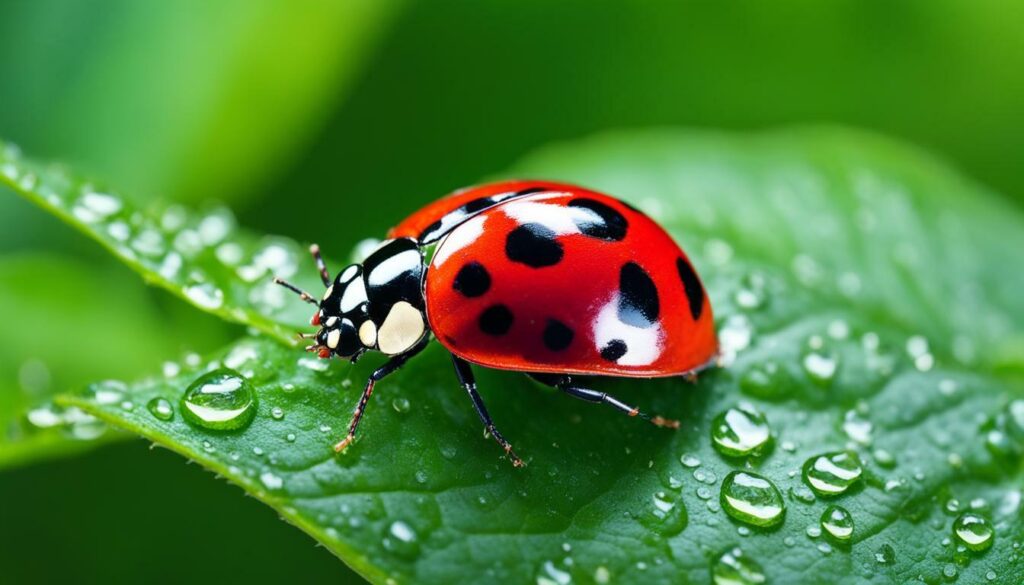
Furthermore, ladybugs are indicators of a healthy ecosystem. Their presence in an area indicates that the environment is rich in food sources and free from harmful pesticides. As sensitive creatures, they serve as a barometer for the overall well-being of specific habitats. Therefore, the presence of ladybugs in our surroundings is a positive sign of biodiversity and ecological balance.
In conclusion, ladybugs are much more than just cute little creatures with colorful shells. They are eco-heroes, contributing to the balance of nature through their role as predators, pollinators, and indicators of a healthy ecosystem. So, next time you spot a ladybug, take a moment to appreciate their vital contribution to the delicate web of life that sustains us all.
Dive Deeper into the Enchanting World of Ladybugs!
Congratulations on diving into the enchanting world of ladybugs! Now, let’s take our journey even further and delve deeper into the fascinating lives of these delightful creatures. Ladybugs, also known as lady beetles, are truly remarkable insects that play a vital role in the ecosystem.
With their vibrant and colorful appearance, featuring red or orange bodies with black spots, ladybugs are a sight to behold. But did you know that they can come in various colors and patterns? Their unique coloration is just one of the many captivating aspects of these tiny creatures.
Not only are ladybugs visually stunning, but they are also beneficial to humans and plants. They play a crucial role in controlling aphids and other plant-eating pests, with a single ladybug consuming up to 5,000 insects in its lifetime. Their voracious appetite makes them nature’s very own pest control superheroes!
Ladybugs have some intriguing defense mechanisms as well. When threatened, they can secrete a foul-tasting fluid or even play dead to ward off predators. It’s truly fascinating how these tiny insects have developed such clever ways to protect themselves.
Throughout their lives, ladybugs undergo a complete metamorphosis, starting as eggs and progressing through the stages of larva, pupa, and finally, adulthood. They can be found in various habitats, but during the winter, they seek out secluded places to hibernate.
The cultural history of ladybugs is also worth exploring. These charming creatures have long been associated with good luck in many cultures around the world. Their presence is believed to bring blessings and positivity.
With over 5,000 species of ladybugs, each with its own unique characteristics and preferred habitat, there is so much more to discover about these enchanting insects. They truly are a testament to the incredible diversity of life on our planet.
So, let’s continue our exploration of the enchanting world of ladybugs and appreciate the wonders that these fascinating creatures offer. There is still so much more to uncover, and who knows what fascinating secrets we may unveil along the way!
FAQ
How many species of ladybugs are there?
There are over 5,000 species of ladybugs, each with their own unique characteristics and preferred habitat.
What do ladybugs eat?
Ladybugs primarily feed on aphids and other plant-eating pests. A single ladybug can consume up to 5,000 insects in its lifetime.
How do ladybugs defend themselves?
Ladybugs have various defense mechanisms, including secreting a foul-tasting fluid and playing dead, to ward off predators.
Where do ladybugs lay their eggs?
Ladybugs lay their eggs near aphid colonies, as the larvae that hatch from these eggs are also predators and feed on aphids.
What is the life cycle of a ladybug?
Ladybugs undergo a complete metamorphosis, going through the stages of egg, larva, pupa, and adult.
Where can ladybugs be found?
Ladybugs can be found in various habitats and tend to hibernate in secluded places during the winter.
Are ladybugs associated with good luck?
Yes, ladybugs have a rich cultural history and are often associated with good luck in many cultures.
Do ladybugs sleep?
The sleeping habits of ladybugs are not well-known, but they may have sleep-like behaviors.
Can ladybugs swim?
Ladybugs are not known for their swimming abilities, but they can interact with water.
Do ladybugs eat grass?
Ladybugs primarily feed on aphids and other plant-eating pests, but they do not typically eat grass.
What is the role of ladybugs in pollination?
While ladybugs are not major pollinators like bees, they do contribute to pollination in some plants.
Are ladybugs attracted to light?
Contrary to popular belief, ladybugs are not particularly attracted to light and may exhibit different behaviors in lighted environments.
Why do ladybug wings stick out?
Ladybugs sometimes have their wings stick out as a defense mechanism to appear larger and deter predators.
How do ladybugs contribute to the balance of nature?
Ladybugs play a vital role in maintaining the balance of nature by controlling aphids and other plant-eating pests, thus protecting plants and promoting biodiversity.
How can I learn more about ladybugs?
Keep diving deeper into the enchanting world of ladybugs by exploring books, articles, and websites dedicated to these fascinating creatures.

